Looking for an authentic Singapore noodles recipe?
You probably won’t find one.
It is the term people in foreign countries give the way the locals prepare the rice vermicelli in Singapore. So it is futile to look for Singapore noodles in Singapore, but available in Chinese restaurants, especially Cantonese restaurants in other countries.
So Singaporeans will be pretty bewildered to see one stir-fried bearing their country’s moniker when they visit places like the United States, Hong Kong, Australia, Canada, and the UK. It is one of the common items on the menu of the Hong Kong cha chaan tengs.
Rice vermicelli is called bee hoon, mee hoon, thin rice noodles, mei fun, or mai fun by the locals, which is the pronunciation of the two Chinese words of the same meaning, 米粉, in different dialects. It is a street food you can find in every nook and cranny of the city. This type of noodles should be available in most Asian grocery stores. So it can also refer to as Singapore mei fun.
Singapore is famous for its food. According to the MICHELIN Guide Singapore, there are 38 starred restaurants in a small island city-state, which is only 739.1 km square.
But rice vermicelli is street food at the opposite end of the spectrum. So isn’t it worth it for us to try?
If you are squeamish about street food, you may be surprised that Liao Fan Chicken Rice Noodle Shop by Hawker Chan has received one star, according to the MICHELIN Guide 2017.
So, let’s dive in and look at the famous Singapore noodles that are world-famous.
1. How is the vermicelli prepared in Singapore and other countries
Singapore noodles 星洲炒米 is the name given to any stir-fried noodles prepared by following the method used by the hawkers in Singapore. Nevertheless, different hawkers use seasonings and ingredients that appeal to them; therefore, there is no one standard cooking method.
Singaporeans staying abroad integrate the local ingredients into their cooking style. Eventually, the stir-fried noodles evolved into a new form and were termed Singapore noodles since the Singaporeans prepared them.
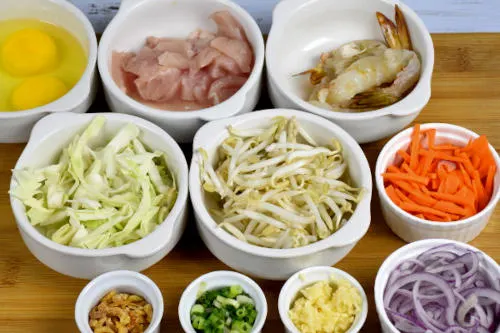
Note: This post may contain affiliate links. Please read my disclosure for more info. I may receive commissions for purchases made through links in this post.
2. Street food style vs. curry powder version Singapore noodles
Before I move on to the Singapore noodles recipe section, here is a comparison between the Singapore noodles overseas and the local street food style ‘economy’ fried noodles at the hawker stores in Singapore.
a. The Singapore version
The vermicelli is presoaked in water, drained, and set aside. The hawker will saute chopped garlic and red onion with vegetable oil or lard, then stir-fried with shrimp, squid, and meat. Some hawkers also add an egg. The egg is either scrambled eggs or make an omelet first, then cut it into thin strips.
The common seasonings are light soy sauce, oyster sauce, dark soy sauce, tomato ketchup, white pepper, and sesame oil. Fish sauce and Shaoxing wine (chinese cooking wine) are occasionally added for the extra kick. Choy sum, cabbage, carrot, and bean sprouts are the common vegetables for stir-fried noodles.
Some stores sell fried noodles cooked with minimal ingredients, usually selling cheaply and serving as the daily breakfast. This barebone version is available in each corner of Singapore, which the locals call economic fried bee hoon 經濟米粉.
The locals like eating noodles with sambal and pickled green chilies as condiments to heat things. Some people also like to add fried shallots to the noodles.
b. Singapore noodles in other countries
The fried noodles named Singapore noodles in non-Asian countries differ from what you can find in Singapore.
Most of these Singapore noodle recipes include Madras curry powder or yellow curry powder as one of the ingredients, which the local hawkers never use. In Malaysia (where I live), tomato ketchup is a common ingredient. One of the cookbooks by Chef Alan Koh even includes Worcestershire sauce.
If choy sum is not available, you may use bok choy 白菜 instead.
The overseas version gives the barebone street food a luxury spin, with more ingredients ranging from plump shrimp and chicken breast meat to Chinese barbeque pork.
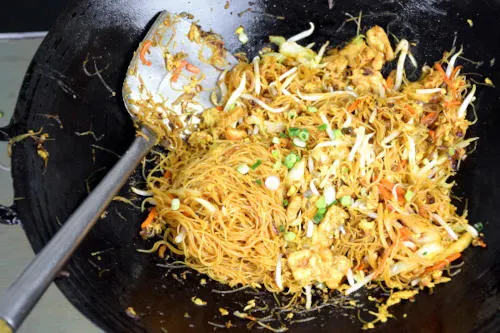
3. The secret to making the rice vermicelli noodles springy and not clumping together
This article will attempt to improvise the classic Singapore street food style fried noodle with a twist, not so much of the ingredient, but the METHOD OF COOKING.
Why?
I have seen many hawker stores offering rice vermicelli that clumps together with a soggy and sticky texture. Either they are missing out on something or taking the easy way out.
This mistake happened to me, too, before I started to dig deeper to find a better way to prepare the noodles.
After a series of tests, I finally deciphered the mystery code that had bothered me all this while. Hopefully, this is one small contribution to finding out how to prepare the best Singapore fried vermicelli recipe.
Here is what I have tested while verifying this Singapore noodles recipe:
The purpose is to solve two problems as below:
1. The rice vermicellis stick to each other and the wok (or a large skillet) while stir-frying.
2. The rice vermicellis become soggy and clump up.
What I want to achieve:
1. To obtain a springy texture.
2. To shorten the stir-frying time. (The longer I fry it, the stickier it becomes).
The cooking method is Blanch the vermicelli in hot water and cool it immediately in cold water.
The result:
This method works and creates a springy texture vermicelli that is not clumpy. Since it has been blanched and partially cooked, I only stir-fry it briefly over medium-high heat and never have any sticky problems.
Why is this cooking method work?
I am not entirely sure why it works, but the closest explanation is that most of the starch has been washed away by blanching it, and hence, they become less sticky (and more springy). For the same reason, it is unlikely to stick together. Furthermore, after blanching, the immersion in cold water will stop further cooking immediately, preventing the vermicelli from overcooking and turning soggy.
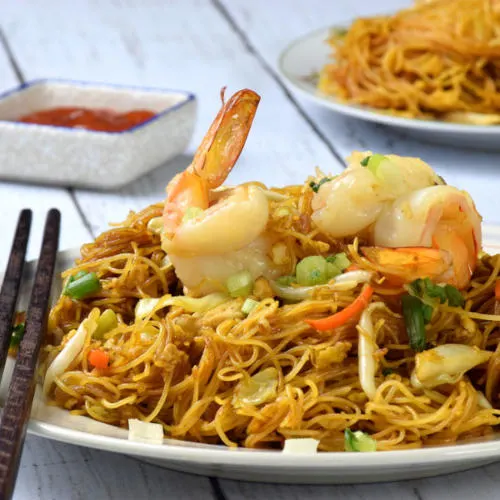
4. Eight tips and useful notes to cook the best Singapore noodles
a. Choice of ingredients
- The meat. Chinese BBQ pork is the most common ingredient (Char Siu / 叉烧). Cut the Char siu into fine julienne. Alternatively, substitute for thin slices of chicken breast meat. The meat is best marinated with light soy sauce, cornstarch, and a pinch of salt. Another popular protein sauce is to add some juicy shrimp.
- The vegetables. The most common greens for the Singapore street food version are bean sprouts, Choy Sum, napa cabbage, and carrots. Some cooks use red onions and snow peas for their crunchiness and some spring onions (green onions) as garnish. As for the bean sprouts, you should divide it into two portions. Add one to the vermicelli during frying, and throw the remaining to a large wok just before turning off the fire so they will still be crispy.
- Dry shrimps. Since non-Asians may not be familiar with dry shrimp, it is an acquired taste for some people. It has a strong umami flavor and is considered an essential item in the recipe. You must wash the dry shrimp with water and soak it for twenty minutes before cooking them. Alternatively, soak it in hot water for five minutes and drain it.
- Dried Chinese mushrooms. Soak the dried Chinese mushrooms until they become soft and hydrated, then cut into small pieces. The soaking will take from one hour to overnight, depending on how large and hard the mushrooms are. Since mushrooms are more expensive than other ingredients, hawkers usually do not use them. However, most restaurants use it due to its aroma.
Most of these items can be found in the Asian grocery store near you.
b. Cooking techniques
- Blanch the vermicelli in boiling water, drain it, and quickly cool in cold water before stir-frying. The cold water treatment is the standard procedure for cooking wonton noodles. I find that it works best for the rice vermicelli, too, and it produces a springy texture and is less sticky.
- Soak the vermicelli for two hours or until thoroughly hydrated and soft before stir-frying. This method is simple to execute, but the texture of the vermicelli will not become springy. The vermicelli will tend to clump together during stir-frying. It is common among hawkers because this method is simple and takes much less time, especially when they must prepare in large quantities.
- Pan-fried the softened vermicelli (using either one of the methods above) in a hot wok until slightly brown and crispy before starting to stir-fry with other ingredients. Chef Pang Fah suggests this technique in his cookbook, but I do not like the lumpy texture and not springy. the pan-fried steps do create an additional aroma that resembles stir-frying over high heat (镬气)
- The amount of rice vermicelli in the recipe refers to the dry weight before blanching. After the blanching, the weight of 200g of dry vermicelli becomes 488g.
The Singapore Noodles Recipe
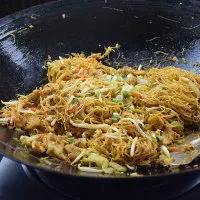
Singapore Noodles (Fried Bee Hoon) Recipe
"Singapore noodles" is the name given to the fried rice vermicelli cooked by the Singaporean. This recipe follows closely how the local hawkers prepared the noodles in Singapore, which is different from the overseas version that includes curry powder in the recipe.
Ingredients
Ingredients A
- 3 tbsp oil
- 2 eggs
- 200 g rice vermicelli
Ingredients B
- 1 tbsp chopped garlic
- 1 medium size onion
Ingredients C
- 80 g chicken breast meat, cut into julienne
- 50 g medium size shrimps, deveined, wash with salt and drained
- 1 tablespoons dry shrimps, soak for 30 minutes and drained
- 40 g cabbage, cut into julienne
- 20 g carrot, cut into julienne
- 50 g bean sprout
- 10 g chopped scallions
Ingredients D (seasoning)
- 3 tbsp tomato ketchup
- 1 tbsp chili sauce
- 2 tbsp oyster sauce
- 1 tbsp light soy sauce
- 1 tbsp dark soy sauce
- 1/4 tsp sesame oil
- 1/8 tsp ground white pepper
Instructions
Preparation
- Bring a pot of water to boil. Blanch the rice vermicelli until soft, which will take about one minute.
- Remove the vermicelli, place it in a pot of cold water. Let it cools down to room temperature. Drain away the water with a wire mesh strainer or colander. Set aside.
- Deveined the shrimps, marinate with a half teaspoon of salt for five minutes, wash in running water until the water runs clear.
- Soak the dry shrimps in hot water for 30 minutes. Drained.
- Cut cabbage and carrot into julienne
- Cut the chicken breast meat into thin slices. Mix with a half teaspoon of cornflour, 1 teaspoon of light soy sauce and one teaspoon of vegetable oil. Marinate for ten minutes.
Stir-fry
- Heat up 2 tablespoons of vegetable oil in the wok. Saute the chopped onions and garlic.
- Add the breast meat, dry shrimps, shrimps and stir-fry until they are cooked.
- Add the cabbage and carrot and stir-fry for another minute. Push all the ingredients to the side of the wok.
- Add 1 tablespoon of vegetable oil and scramble two beaten eggs until nearly cooked. Push back the ingredients to the bottom of the wok and mix with the eggs.
- Add the vermicelli, 2/3 of the bean sprouts and the seasonings (ingredients D). Mix well with the vermicelli. Turn to high heat and stir-fry until aromatic.
- Turn off the heat. Add the remaining bean sprouts and mix well.
- Top with chopped scallion and serve.
Recommended Products
As an Amazon Associate and member of other affiliate programs, I earn from qualifying purchases.
Nutrition Information:
Yield: 1 Serving Size: 1Amount Per Serving: Calories: 1130Total Fat: 58gSaturated Fat: 7gTrans Fat: 0gUnsaturated Fat: 47gCholesterol: 565mgSodium: 5048mgCarbohydrates: 92gFiber: 7gSugar: 22gProtein: 62g
This data was provided and calculated by Nutritionix on 1/28/2019
Frequently asked questions
1. Can I use black pepper instead of white pepper?
You can substitute white pepper with black pepper, but most Asians prefer to cook with white pepper.
2. Can I premix the seasoning (make a Singapore noodle sauce?)
If you are not confident in adding the seasoning (soy sauce, ketchup, etc. directly into the wok, it is wise to premix all the seasonings to become a sauce mixture in a small bowl. Then pour the sauce into the hot wok and stir-fry with the noodles.
3. Do I need the chicken stock to cook the noodles?
You do not need chicken stock or chicken broth to cook Singapore noodles. The seasonings and flavor from the ingredients are already sufficient.
4. How to cook vegan Singapore noodles?
The best practice is to omit the meat and substitute it with firm tofu as the protein sauce.
5. Can I add red bell pepper to prepare it?
You can use red pepper, but it is not the usual way the local does.
6. Lastly, Is this Singapore noodles recipe similar to lo mein and chow mein?
Chow Mien is the American-Chinese version of fried noodles, which were named based on the Chinese character 炒面, which means fried noodles. So, Singapore fried noodles can be considered as one type of Chow Mien. It is different from lo mein as this is a dry noodle version, derived from the two Chinese words 捞面。


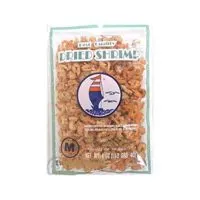
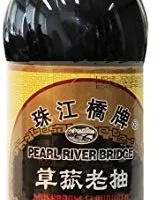
Icy
Friday 27th of January 2023
Thanks for sharing your recipe. It is very informative and I have learned something today. :) My family has benefited from your recipe today.
Pauline Lacy
Thursday 15th of April 2021
This was great!! But Omg does it really have 57g off fat?! I sub tofu for shrimp and chicken it was tasty!!!
Alisa F Gerald
Thursday 26th of November 2020
Thanks for posting this recipe. I was surprised ketchup is used. What does this add to the dish? Does it add a tomato flavor? Or is it just used to thicken the sauce?
KP Kwan
Thursday 26th of November 2020
Ketchup has other components in it besides tomato, and it is used to add flavor.
MJ
Wednesday 6th of May 2020
Hi, I just tried this and liked it! For the Chili sauce, I used those sweet spicy type of Chili sauce is that right?
KP Kwan
Wednesday 6th of May 2020
Hi MJ, I use the chili sauce, which tastes like tomato ketchup plus chili, but you can use any te your like. KP Kwan
Rowena
Sunday 19th of April 2020
Hi, is this recipe spicy? Noted there is chilli, can I omit chilli and ketchup?
KP Kwan
Monday 20th of April 2020
Hi Rowena, You can omit the chili, but ketchup is essential. Thanks. KP Kwan